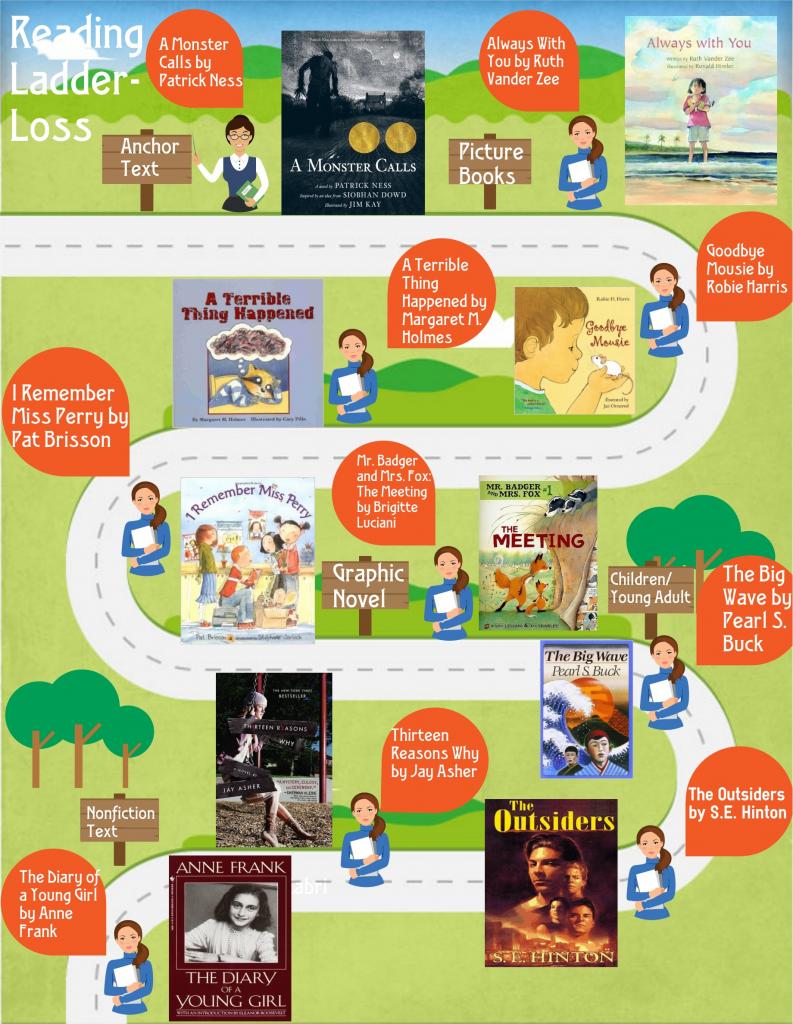Dear Teachers,
I have recently worked on constructing an infographic displaying ten texts that exemplify the theme of “loss.” Students are often not thought to experience something as serious and tragic as “loss,” but they unfortunately do, and more than we think. Whether it be losing a family member, friend, home, etc., it’s hard for students to understand the concept of losing something and knowing how to deal with it. I have collected ten texts that explore stories of loss and how the characters deal with their emotions and overcome that obstacle. I encourage you to display my infographic, which contains four picture books, four young adult novels, one graphic text, and one nonfiction text, in your classroom as a resource for your students. We don’t always know what students are dealing with, and they aren’t always willing to talk about it, so providing them with a resource that allows them to deal with their emotions, such as through reading, can really help them get through what they are feeling and experiencing and not feel alone.
The first book in my pictograph is a young adult novel, A Monster Calls by Patrick Ness, which I use as the anchor text for the theme, and it fits the theme of “loss” because it takes us on a journey of how a boy is coping with the fact that his mother is dying from cancer, and the unique way the boy deals with the approaching death-by seeking out a monster.
I then provide four picture books on my infographic. Always With You by Ruth Vander Zee, fits the theme of “loss” because we see a young girl lose her mother and village to an explosion in Vietnam, and how she deals with the loss and carries on after her mother’s death and she is taken to an orphanage by remembering her mother’s promise that she “will always be with you.” Goodbye Mousie by Robie Harris fits the theme of “loss” because we see a young child face the loss of a pet, which is a mouse in this case, and how the child’s parents help their child overcome the stages of grief and loss. A Terrible Thing Happened by Margaret M. Holmes fits the theme of “loss” because it takes us on a journey to show how “seeing something terrible” can affect a child, like witnessing a death. Sherman has bad dreams and always felt nervous, but then begins to be relieved and feels better when he is able to talk about the event he witnessed. I Remember Miss Perry by Pat Brisson fits the theme of “loss” because it reveals that sometimes, tragic things can happen to people who aren’t family or someone that is older in age, like a teacher. Miss Perry is very warm and welcoming to her students, and after the students have fallen in love with her and her ‘fondest wishes,’ she passes away after being involved in a car accident. The students but then learn to accept what has happened, and then decide what Miss Perry would want them to do, which would be her ‘fondest wish,’ which would be for them to find their happiness again.
Next on my infographic is a graphic novel. The Meeting (Mr. Badger and Mrs. Fox Series #1) by Brigitte Luciani fits the theme of “loss” because often when we think of loss, we think of losing a person, but we can also experience the feeling of grief in other situations, like losing one’s home. Mrs. Fox and her daughter are chased out of their own home by a hunter’s dog, and are forced to find a new home in a tunnel with Mr. Badger and his two children. Losing a home can be very similar to losing a loved one, because you lose memories that you experienced there. This book shows how something positive, like a new family, can come from experiencing something as tragic as losing your home.
Next on the infographic are three young adult novels. The Big Wave by Pearl S. Buck fits the theme of “loss” because we see Jiya, a young fisherman boy lose his entire family to a tsunami in Japan. Jiya is taken in by his best friend’s family and adopted by them, and he finds happiness again through his best friend and his family’s kindness. The Outsiders by S.E. Hinton fits the theme of “loss” because we see a group of friends, who have endured it all together, lose two of their pack, Dally and Johnny. This novel deals with the loss of friends and enemies, and how death all-around affects everyone, regardless if you’re a “soc” or “greaser.” Thirteen Reasons Why by Jay Asher fits the theme of “loss” because it takes readers through the experience of Clay losing a classmate to suicide. Clay experiences confusion and desperation as he listens to a cassette tape that Hannah has left him, giving him thirteen reasons why she decided to take her own life. Experiencing death of a loved one is one thing, but accepting that a loved one decided to take their own life, something that could have been prevented, is a whole other world of emotions, which Jay Asher takes us through with Clay.
The infographic is wrapped up by a nonfiction text, The Diary of a Young Girl by Anne Frank. This text uniquely fits the theme of “loss” because we are taken through the personal journey of a young girl who is losing her home, friends, and everything she knows during the Nazi takeover in the Netherlands. We see exactly how she feels and reacts, and the extent of what she has to do to survive, like living in hiding for over two years, and then dying at a concentration camp. The readers experience the feelings of loss as Anne Frank describes them, and then the reader also loses the author/narrator at the end of the diary, so we experience our own personal loss.
Sincerely,
Lauren Batten

.jpg)